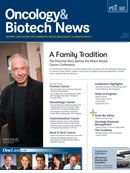Publication
Article
Oncology & Biotech News
Chemotherapy Alone With No Radiation Superior for Limited-Stage Hodgkin Lymphoma
Author(s):
It may be possible to forgo radiation in previously untreated patients with limited-stage Hodgkin lymphoma.
Ralph M. Meyer, MD
It may be possible to forgo radiation in previously untreated patients with limited-stage Hodgkin lymphoma (HL), according to long-term followup of the NCIC CTG/ECOG (National Cancer Institute of Canada Clinical Trials Group/Eastern Cooperative Oncology Group) Hodgkin’s Disease 6 (HD.6) trial presented at the 53rd Annual ASH Meeting. At 12 years, long-term overall survival (OS) was 7% higher with ABVD (adriamycin or doxorubicin, bleomycin, vinblastine, and dacarbazine) chemotherapy alone than in the radiation-containing arms, and late second cancers and cardiovascular events were higher with radiation. The study was published in The New England Journal of Medicine to coincide with the ASH presentation.
Patients with limited-stage HL are generally treated with combination chemotherapy plus radiation. Although this approach is highly effective, late effects of radiation are cause for concern. There is a growing trend in the United States to avoid radiation in early-stage limited HL, said Jane N. Winter, MD, Feinberg School of Medicine, Northwestern University, Chicago, Illinois. Winter, who moderated a press conference where these results were presented, was involved in the design of HD.6 but not in its conduct.
The HD.6 trial enrolled 405 previously untreated patients with stage IA or IIA nonbulky HL, and compared 12-year OS in patients treated with ABVD alone or radiation plus or minus ABVD. Patients were stratified into low- or high-risk categories prior to randomization. ABVD alone improved OS compared with radiation alone or radiation combined with ABVD. The 12- year OS was 94% for ABVD versus 87% for those who received radiation (P = .04).
At 12 years of follow-up, however, the ABVD arm had a lower rate of freedom from disease progression (FFDP) compared with radiation therapy: 87% versus 92%, respectively (P = .05). The same pattern of OS and FFDP results prevailed in high-risk patients: OS for high-risk patients was 92% in the ABVD arm versus 81% in the radiation arm; FFDP was 87% versus 94%. In this trial, therefore, progression-free survival (PFS) was not a predictor of OS.
“Our results alter the debate about the use of chemotherapy alone in limited-stage HL. The 12-year rates of 87% for FFDP and 94% for OS in the ABVD arm suggest that chemotherapy alone can now more confidently be a therapeutic option for this population,” said lead author Ralph M. Meyer, MD, director of the NCIC Clinical Trials Group, and professor at Queens University in Kingston, Ontario, Canada.
Meyer also commented on the lower rate of FFDP in the ABVD arm. “The standard paradigm that keeping disease away [ie, FFDP] leads to living longer doesn’t hold in this trial. These results show that improved long-term survival is less dependent than previously assumed on further reducing deaths due to progressive HL and instead emphasize a need for treatments that will not lead to deaths from late treatment effects,” he said.
“
These results show that improved longterm survival is less dependent than previously assumed on further reducing deaths due to progressive HL and instead emphasize a need for treatments that will not lead to deaths from late treatment effects. ”
—Ralph M. Meyer, MD
Overall, late effects of radiation were lower in the ABVD arm. Second cancers were reported in 10 patients in the ABVD arm versus 23 in those treated with radiation. Cardiac events were reported in 16 patients treated with ABVD versus 26 patients who received radiation. Deaths due to second cancers were 10 in the radiation arm versus 4 in the ABVD arm, and deaths from causes other than HL or second cancers were also higher in the radiation arm: 10 versus 2, respectively.
According to Meyer, the superior OS in the ABVD-alone arm is related to fewer deaths from causes other than HL. “Radiation as used in this trial is outdated and excessive, and likely contributed to the excess deaths,” he said.
David J. Straus, MD
In an accompanying editorial in The New England Journal of Medicine, David J. Straus, MD, Memorial Sloan-Kettering Cancer Center, New York City, wrote that modern radiation techniques may be less toxic than those used in HD.6, but nevertheless, radiationinduced complications may still increase long-term mortality. PET-adapted therapy now emerging at some academic centers may actually lead to use of increased volumes of radiation.
Straus emphasized that radiation should be limited to the subgroup of patients where the benefits outweigh the risks, but that subgroup needs to be clearly defined.
“Limiting the use of radiation therapy to the fraction of patients who require it should make an important contribution to the ultimate goal of maximizing the long-term cure rate while minimizing late morbidity and mortality,” Straus wrote.
Meyer RM, Gospodarowicz M, Connors JM, et al. Final analysis of a randomized comparison of ABVD chemotherapy with a strategy that includes radiation therapy in patients with limited-stage Hodgkin lymphoma: NCIC CTG/ECOG HD.6. Blood. (ASH Annual Meeting Abstracts) 2011;118(21, abstr 590).










